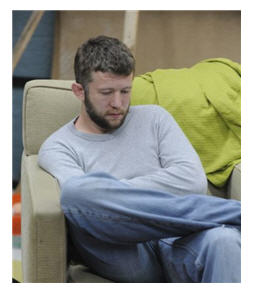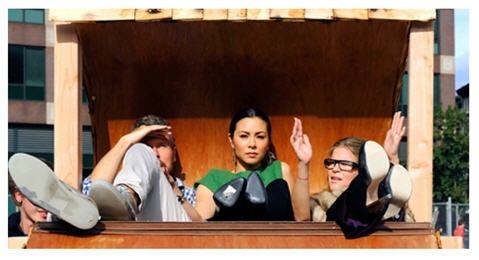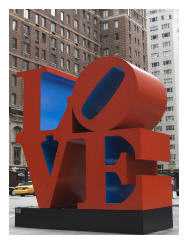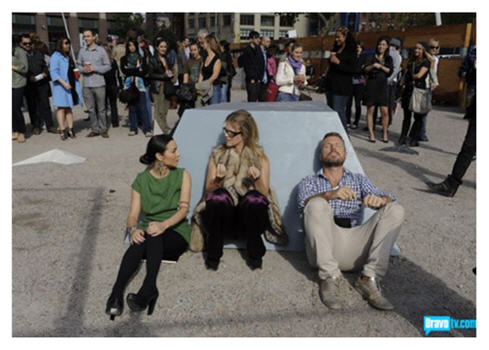Welcome to the Work of Art Episode 6 smack-down! We’re about midway through Season 1, so isn’t it time to see if the contestants play well in groups?
 Yes, indeed. It wouldn’t be the formula we love to hate if we didn’t stir the pot, turn up the heat, and watch our favorite personalities go at each other under pressure. Last evening was the Erik and Miles show, with a little bit of Jackie in a supporting role.
Yes, indeed. It wouldn’t be the formula we love to hate if we didn’t stir the pot, turn up the heat, and watch our favorite personalities go at each other under pressure. Last evening was the Erik and Miles show, with a little bit of Jackie in a supporting role.
Some of the lowlights?
Erik to Miles:
I’m not your fucking helper, dude.
Erik about Miles:
I’ve been around too much to have some stuck up art pussy tell me life lessons.
Erik on Miles’s idea for the sculpture:
And you built another homeless shelter.
I give Erik points on that one. At least, it started out part homeless shelter-quiet space, part tree house. And doesn’t succeed as either – for originality or finished product.
Open to the public?
I can’t say I enjoyed last night’s “Open to the Public” episode. I don’t care to watch adults act like 9-year olds. The challenge was worthy, and difficult – a sculpture or installation with a social message, for a public space, working in teams of four. (The Red Team – Nicole, Abdi, Ryan, Mark, and the Blue Team – Miles, Jaclyn, Peregrine, Erik.) There was a quick trip to LentSpace in Lower Manhattan, where the work would be installed, then two days to complete the task at hand.
 The Red Team acted like adults (*sigh of relief*), but on the Blue Team, Erik and Miles get into it, the ladies try to break it up, Jaclyn passes a note to Erik (may I repeat – fourth grade?) and we have yelling, name calling, hurt feelings, and frankly – a crappy end result.
The Red Team acted like adults (*sigh of relief*), but on the Blue Team, Erik and Miles get into it, the ladies try to break it up, Jaclyn passes a note to Erik (may I repeat – fourth grade?) and we have yelling, name calling, hurt feelings, and frankly – a crappy end result.
And speaking of end result, perhaps we should recall that the assignment is making art, taking inspiration from an exterior location, relating to the environment, and creating a public presence that people will interact with.
Public art that sticks and pleases
Public art is problematic, as guest judge Yvonne Force Villareal seems to point out, requiring many voices to agree, collaborate, and compromise. Yet public art enlivens both urban and rural landscapes.
A few examples that pop into my mind immediately:
- Robert Indiana’s 1967 LOVE sculpture

- Sol LeWitt’s 54 Columns in Atlanta
- Jonathan Borofsky’s towering Walking to the Sky in New York
Of course, the judges made mention of the Jeff Koons Puppy, displayed at Rockefeller Center, created with steel, soil, and plants, as an example of successful public art. Sorry. Not a fan. Give me Borofsky, Richard Serra, Sol LeWitt, or even Niki de Saint Phalle with her colorful, whimsical public sculptures.
Ah yes. Then there is the issue of social message. Public art should say something. Of course, some would say that all art should say something. (Time for me to be a heretic? And the Jeff Koons Puppy is saying what, again?) Quick! Call in the spin doctors!
The competition
Nicole got my vote for thoughtfulness when she first stretched out on the ground in order to get a better sense of the space, and to experience it. She picked up the gravel beneath her fingers. She felt it, looked at it, saw the beauty in the shapes. This is what inspired the design for the Red Team – a large geometric structure surrounded by several considerably smaller ones.
 While I didn’t especially care for the result (Sol LeWitt geometrics meet 1960s Star Trek landscape?), I did enjoy watching the team at work – as they constructed their monolithic structure out of plywood, and surrounded it with smaller forms in cast concrete.
While I didn’t especially care for the result (Sol LeWitt geometrics meet 1960s Star Trek landscape?), I did enjoy watching the team at work – as they constructed their monolithic structure out of plywood, and surrounded it with smaller forms in cast concrete.
As for the battling Blues?
I didn’t like Miles’s initial idea (an urban tree house?) nor the finished product – a hodgepodge of wood and aluminum that reminded me of a playground apparatus gone bad.
Challenges of public art
 The issues behind the challenge are more interesting – the complexity of commissioning, approving, siting, and creating any work for public consumption – the involvement of city planners, politicians, lawyers – who themselves must fight it out and eventually agree. There are concerns about a broad (essentially faceless) community responding to whatever is installed (residents and visitors), ensuring the work is structurally sound (safe), and minimizing the likelihood of vandalism.
The issues behind the challenge are more interesting – the complexity of commissioning, approving, siting, and creating any work for public consumption – the involvement of city planners, politicians, lawyers – who themselves must fight it out and eventually agree. There are concerns about a broad (essentially faceless) community responding to whatever is installed (residents and visitors), ensuring the work is structurally sound (safe), and minimizing the likelihood of vandalism.
The reality is that artists don’t work in a vacuum, though they may wish they did. Generally, they must interact with others who support their efforts – galleries or dealers who will assist with showing the work and selling it, critics who will like it and write about it, patrons who will purchase it.
More to probe?
Erik raised the perpetual debate typical among creative types – the need for formal training versus being self-taught. Have all great artists attended art school and studied art history? Of course not, but I dare say they don’t think it’s unimportant to learn – however you accomplish that, so you know what is innovative and what isn’t. What “works” and why.
What doesn’t work, for me? Watching so-called adults act like kids. If I want fourth graders, I’ll volunteer at the local elementary school, and teach a class on the value of working as a team.
Last night was the last episode I will watch. The judges threw out the guy who agreed with them on the losing piece.
Makes no sense unless this is less a show about how art is made and more about pompous artistic assholes who don’t realize you can be an artist whether you’ve been to art school or not.
Erik could have responded in a more positive way to the “stuck up art pussy.” I don’t think his attitude had anything to do with him leaving the show though.
I like folks who play fair and last night the judges failed to do that and I have a feeling that, that is an indication of how the show will go from here out.
I agree. Wretched handling all round. And Jerry Saltz pushing Erik with “Why, Why, Why” comes across as far more bullying than anything the other artists subjected him to. (Do we suspect why he’s doing this? Sure. But it doesn’t make it any prettier to watch.)
I remind myself there’s a great deal of footage we never see, but this episode was irritating on many levels.
Christo and Jeanne-Claude’s The Gates:
http://www.northcountrypublicradio.org/news/gates/gallery/gates01.jpg
A big YES to Christo and Jeanne-Claude. Also – Angel Orensantz. Some of his works are magical.
Remember Christo’s “Umbrellas”? My mom and brother visited the California version of that. My mom has a framed photo she took of one of the umbrellas. It makes me feel cultured that I’m her son! 🙂
I imagine getting different artists to work in a group together would cause sparks.
Have never seen any Christo in person, DM. Would love to! (And actually, getting anyone to work well in groups is tough, isn’t it? And creative types? Even tougher, I’m guessing.)
Having been to arts school (to the extent film school is art school) I ended up believing that you can cultivate artists, but you cannot make them.
I’m looking forward to Netflixing this show when it’s complete (as I don’t get the show on cable), but I appreciate glimpses into it and your observations on creative process.